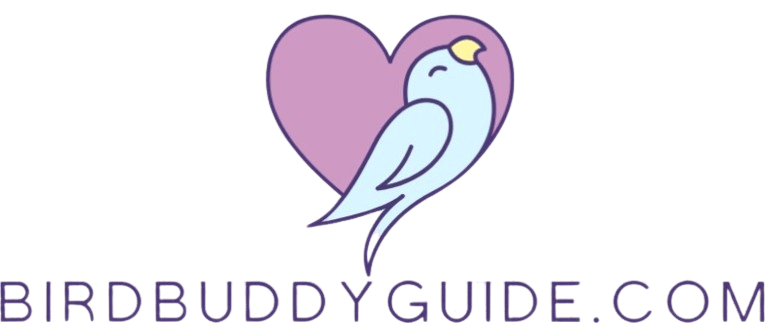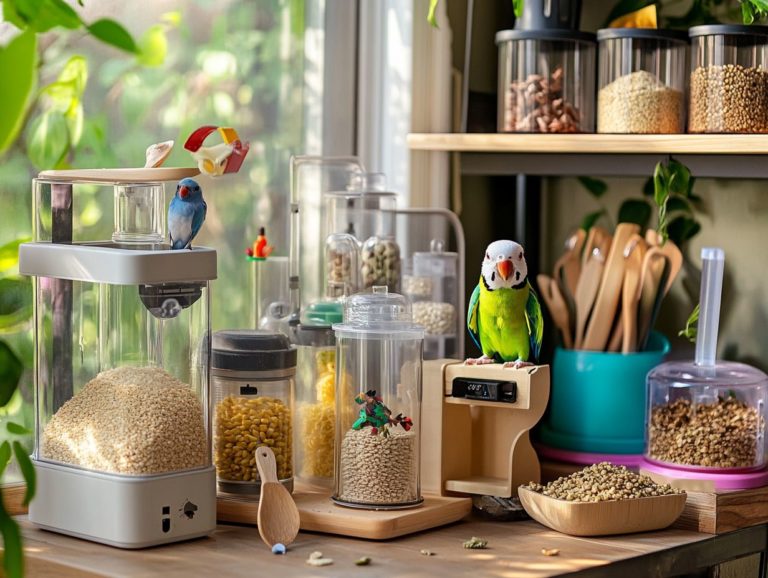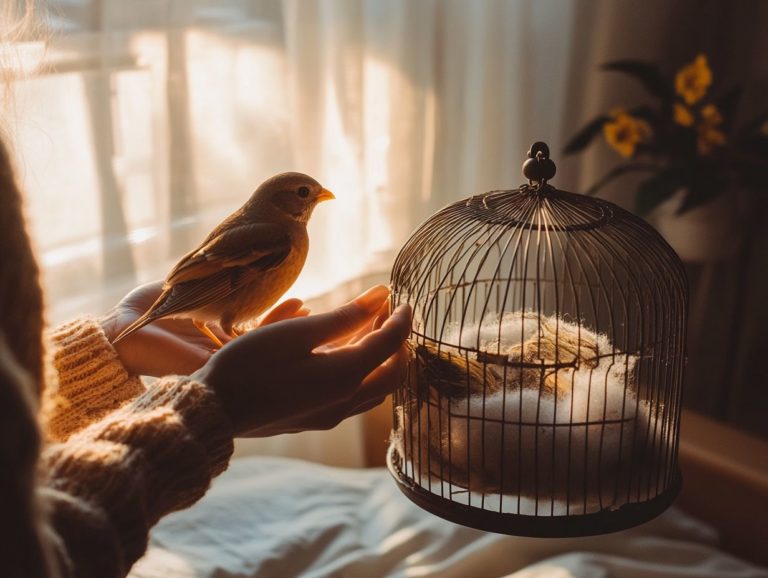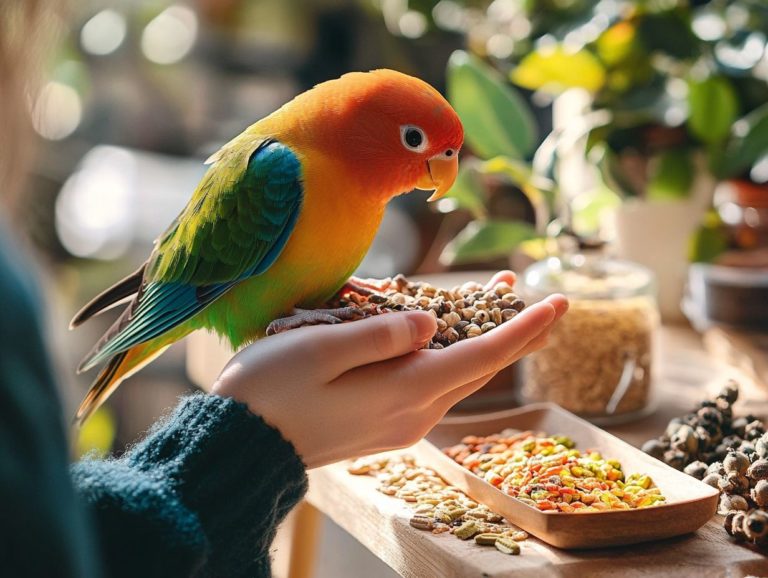Is it Safe to Let My Bird Fly Free?
The question of whether to let birds fly free ignites passionate debates among pet owners and avian enthusiasts alike.
While the benefits of granting your feathered friends the freedom to soar and explore are compelling, it’s crucial to consider the safety risks they face in the wild and their interactions with humans.
Let s explore the advantages of free flying for birds, examine the potential risks involved, and offer practical tips for safely training your bird.
This article also offers enriching alternatives for those who prefer to keep their birds indoors.
Join us as we navigate the complexities of free flying and its impact on your beloved companions.
Contents
- Key Takeaways:
- The Debate on Free Flying Birds
- Benefits of Free Flying for Birds
- Potential Risks of Free Flying
- How to Safely Free Fly Your Bird
- Alternatives to Free Flying
- Frequently Asked Questions
- Is it Safe to Let My Bird Fly Free?
- What precautions should I take when letting my bird fly free in various countries?
- Can my bird get injured while flying free?
- What if my bird flies away and doesn’t come back? Should I contact local bird rescue organizations for help?
- Is it safe to let my bird fly free outside, especially with predators like hawks?
- How can I train my bird to fly free safely?
Key Takeaways:

- Allow your bird to fly free in a safe and controlled environment to promote natural behaviors and mental stimulation.
- Weigh the potential risks of free flying, such as dangers in the wild and human interactions, before deciding what’s best for your bird’s safety.
- If you choose to free fly your bird, take necessary precautions and provide proper training to ensure a safe and enjoyable experience for both you and your bird.
The Debate on Free Flying Birds
The discussion surrounding free-flying birds presents diverse viewpoints, especially among parrot owners who champion the mental and physical benefits of free flight while acknowledging the risks involved.
Allowing birds such as GW macaws and Timnehs to soar freely lets them showcase their unique personalities and engage in instinctual behaviors, fostering a supportive community dedicated to their well-being.
However, this dialogue is complex; significant safety concerns emerge. The many risks associated with outdoor flight pose potential threats to these magnificent creatures, demanding careful consideration from every bird lover.
Arguments for and Against Letting Birds Fly Free
Arguments surrounding the freedom of birds often revolve around the mental and physical benefits that free flight offers, which many believe are essential for a parrot’s overall well-being, alongside the risks that come with uncontrolled environments.
Proponents of free flight argue that this liberty fosters critical mental stimulation and physical exercise, enabling parrots to engage in natural behaviors vital for their happiness. However, you must also consider the potential dangers. Interactions with wildlife can pose significant threats, such as predation or disease, while encounters with humans may lead to stressful situations.
Positive reinforcement training can help mitigate some of these risks, encouraging safe behaviors while your parrot explores the great outdoors. Community support is invaluable; sharing experiences and knowledge about safe free flying creates a collective understanding of how to navigate the joys and hazards of allowing these vibrant creatures to truly spread their wings.
Benefits of Free Flying for Birds
The benefits of free flying for birds are remarkable. This practice elevates their mental and physical health and enables them to exhibit natural behaviors often stifled in captivity.
When your birds take to the skies, they experience a profound sense of freedom and autonomy, essential for their psychological well-being. This enhances their quality of life and deepens the bond between you and your feathered companions, fostering a supportive community among fellow enthusiasts who share your passion.
Share your experiences with free flying! We d love to hear your stories.
Natural Behaviors and Mental Stimulation
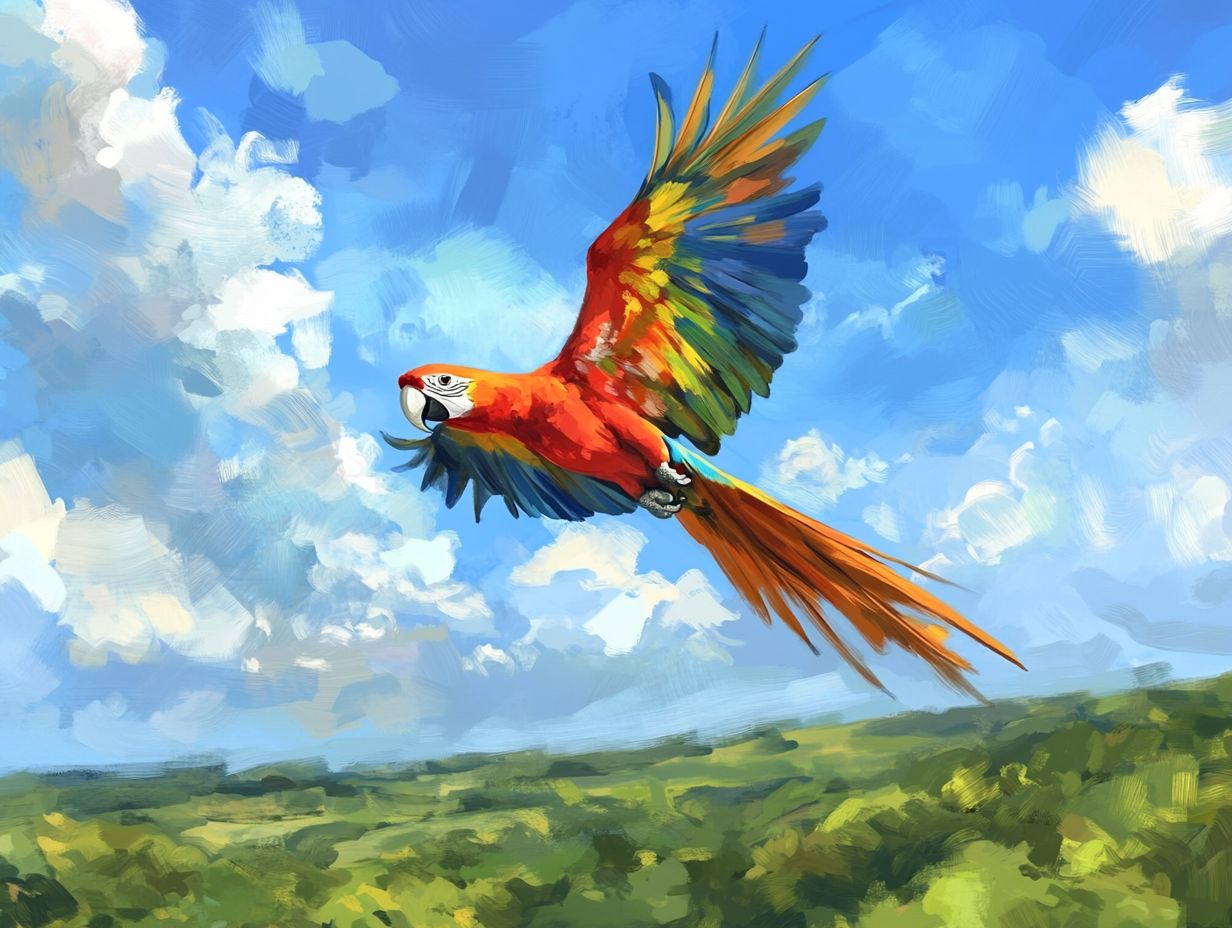
Engaging in free flying allows birds to exhibit their natural behaviors and enhances their mental stimulation, essential for overall health and happiness. This natural outlet nurtures their instincts and creates an enriching environment that alleviates boredom and reduces stress.
When birds explore their surroundings, they engage in behaviors like foraging and socializing, similar to their wild counterparts. As a parrot owner, encourage these explorative tendencies by using positive reinforcement techniques. Reward your feathered friend with treats or praise when they respond to cues like flapping their wings or returning from a flight.
Being aware of these behaviors helps you build a strong bond rooted in mutual trust and understanding, fostering a fulfilling and active lifestyle for your avian companions.
Potential Risks of Free Flying
While free flying offers numerous advantages, it also comes with risks that every bird owner must consider to safeguard their cherished pets.
Threats like dogs, hawks, and falcons pose serious dangers. The unsettling possibility of encountering unpredictable individuals with firearms outdoors can also lead to precarious situations for free-flying birds.
Dangers in the Wild and Human Interactions
Free-flying birds encounter numerous dangers, including threats from wild animals like hawks, crows, and dogs. Unpredictable human interactions can also jeopardize their safety.
These encounters can result in distressing outcomes for avian species, whether it’s a hawk swooping down unexpectedly or a curious dog giving chase. Your actions can amplify these threats. For example, when people feed birds, they might attract predators, creating dangerous confrontations.
Stay alert! Your attention can make all the difference for free-flying birds. Recognizing that actions like leaving trash behind or providing unsuitable food can have dire consequences is vital.
Such awareness and proactive measures are crucial for safeguarding free-flying birds, allowing them to thrive in their natural habitats.
How to Safely Free Fly Your Bird
To safely free fly your bird, adopt effective training techniques that ensure your bird’s readiness and the safety of its surroundings.
Training a parrot requires understanding its special traits and creating a bird-proof area where it can explore under your watchful eye. This approach fosters its natural instincts and enhances your ability to monitor potential risks.
Training and Precautions

Effective training and appropriate precautions are essential for preparing your parrot for free flying, ensuring a safe flight experience.
Introduce your bird to outdoor environments gradually. This allows your parrot to acclimate to various sounds, sights, and weather conditions in a controlled manner. Using positive reinforcement techniques like treats and praise enhances the training process, helping your parrot associate outdoor exploration with rewarding experiences.
Supervision during these initial outings is crucial for safety, offering extra protection against potential hazards. Within this community, fellow enthusiasts are eager to share tips and strategies that highlight safe practices and effective methods for nurturing your bird’s flying skills.
Alternatives to Free Flying
Alternatives to free flying present invaluable opportunities for enrichment and exercise. These options allow you to keep your parrot active and engaged while minimizing risks. Explore various methods that enhance your bird’s quality of life.
Consider options like supervised out-of-cage play, which can simulate flight-like experiences. This creates a sense of community where bird owners can share successful alternatives that have worked wonders for their feathered companions.
Other Ways to Provide Enrichment and Exercise
There are countless ways to enrich and exercise your bird beyond traditional free flying. Consider incorporating interactive toys, obstacle courses, and supervised out-of-cage time into their routine.
Engaging with the community significantly enhances your bird’s well-being. Participating in organized events like “Parrot Playdates” allows you to exchange ideas and activities, fostering socialization for both your feathered friend and yourself.
Workshops on crafting safe, homemade toys can spark creativity. Group outings to parks or outdoor aviaries introduce unique environments for exploration.
By co-creating obstacle courses using natural branches and safe materials, you’ll boost their physical agility and mental challenges, promoting a lifestyle that results in happier, more fulfilled companions.
Frequently Asked Questions
Is it Safe to Let My Bird Fly Free?

Yes, it is safe to let your bird fly free as long as certain precautions are taken.
What precautions should I take when letting my bird fly free in various countries?
Ensure the area is bird-proof to avoid accidents. This includes removing hazards like dogs and wild bird droppings. Supervise your bird at all times and have a plan for retrieving them if they fly away.
Can my bird get injured while flying free?
While there is always a risk of injury when birds fly, particularly from humans with harmful intentions, the risk is minimal in a safe and supervised environment.
What if my bird flies away and doesn’t come back? Should I contact local bird rescue organizations for help?
If your bird is properly trained and bonded with you, chances are they will return. Always have a plan in case they fly away, such as contacting local bird rescue organizations or free-flight trainers.
Is it safe to let my bird fly free outside, especially with predators like hawks?
No, it is generally not safe to let your bird fly free outside unless it is in a securely enclosed area, as dangers like hawks, crows, and ravens can pose significant risks.
How can I train my bird to fly free safely?
Start training your bird in a safe and familiar environment, gradually increasing the space and duration of their flights. Use positive reinforcement, rewarding good behavior, and never force your bird to fly if they are not comfortable.
